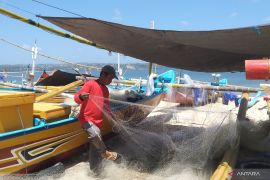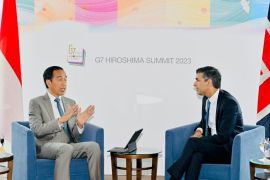Sometimes, the technology from the leaders is not always economically appropriate ..."Jakarta (ANTARA News) - Indonesia should not harbor concerns over depleting fossil fuel reserves since it is rich in renewables, as the sources of energy in the future, and geothermal is one of the countrys renewable source assets.
Geothermal power in Indonesia is an increasingly significant source of renewable energy, and as a result of its volcanic geology, it is often reported that the country has 40 percent of the worlds potential geothermal resources, which is estimated to be 29 thousand megawatts (MW).
However, Indonesia requires funds to develop its new and renewable sources of energy. The government wants renewable sources to contribute 23 percent of the countrys energy mix by 2025, and the country has pledged to reduce its greenhouse gas emissions by 29 percent by 2030.
In order to facilitate the development of renewable sources of energy, the Energy and Mineral Resources (ESDM) Ministry is encouraging PT Sarana Multi Infrastruktur (SMI), a state-owned infrastructure funding company, to help develop new and renewable energy by disbursing low-interest loans.
At a presentation of a Micro Hydro project for Indonesia in Jakarta on Thursday, Deputy ESDM Minister Arcandra Tahar said the government is looking for cheap funds to develop the potential of new and renewable energy in Indonesia.
"We, at the ministry, are trying to bring in lenders who can offer us a cheap interest rate, and we are looking to source cheap funds, including from the SMI. We encourage the SMI to spend some of its funds for the development of new and renewable energy," he remarked.
Tahar said several financial institutions are offering funding assistance. European lenders are offering an interest rate at below five percent.
Nevertheless, he admitted that until now, none of the offers can be realized, as the government is also making calculations and studying their requirements.
One of the proposed conditions concerns the application of technology whose economic value still needs to be computed by the government, according to the deputy minister.
"The government is still making calculations to evaluate the economic value of the funding interest rate. Sometimes, the technology from the leaders is not always economically appropriate, so it should be calculated first," he pointed out.
Arcandra stressed that the government will continue to bring in lenders offering cheap loans to cater to the need to develop the countrys renewable energy potential.
The ESDM Ministry has also gathered stakeholders several times to work on it.
"The government is doing its best. This is a B-to-B deal. One of the governments instruments is using the SMI. The other instruments are foreign lenders that are able to provide soft loans," he said.
The ESDM Ministry has recorded that the total renewable energy potential in Indonesia reached 441.7 gigawatts (GW).
However, based on data from the Directorate General of Renewable Energy and Energy Conservation of the ESDM, of the 441.7 GW, only two percent, or 8.8 GW, has been generated from the plant installed this year.
Hence, the House of Representatives has supported the governments efforts to continue to develop the countrys new and renewable sources of energy, particularly geothermal, whose reserves in Indonesia are considered to be the largest in the world.
"I invite all of you to set a common goal to spur the development of environment-friendly renewable energy, so that the target to reduce emissions by 29 percent in 2030 can be achieved," said the DPR Agus Hermanto in Jakarta, Friday (Oct 6).
The legislator reminded that to realize the target of 23 percent renewable energy use, the use of renewable energy resources or environment-friendly energy must be increased.
Hermanto, who is a Democratic Party politician, also warned that a new and renewable energy policy had been contained in Presidential Regulation No. 79 of 2014 on the National Energy Policy. It aimed to develop alternative energy sources in lieu of fuel oil, while renewable energy was targeted to reach 23 percent by 2025, he added.
Admittedly, there are many challenges to develop environment-friendly energy for the creation of clean air. The main challenge lies in the certainty of regulation and the economic aspects of developing renewable energy.
In addition to this, it would take bold steps in the form of policy and political will together to encourage the development of clean environment-friendly energy.
In reaching the new and renewable energy target of 23 percent by 2025, the government has devised various strategies. In the geothermal field, for example, the Minister of Energy and Mineral Resources has issued Regulation No. 36 on Preliminary Survey Assignment Procedure (PSP) and Preliminary Survey Assignment and Exploration (PSPE).
Through this introduction and the PSPE Assignment mechanism, the Government may assign the business entity to conduct geological, geochemical, geophysical, and/or integrated evaluation activities up to the drilling of exploration wells to obtain information on geothermal reserve estimates.
The PSPE mechanism will help potential geothermal investors to ensure geothermal reserves gain more comprehensive economic value calculations, mitigate future development risks, and greater opportunities to secure project finance by delivering more bankable data and information.
Several other breakthroughs that have been made to increase geothermal investments include assignments of state-owned enterprises to improve the investments, based on Law No. 21 of 2014 on Geothermal Exploration, Fiscal Incentives, Tax Allowance and Non-Fiscal Incentives.
The government, moreover, also simplifies the procedures of receiving license for the exploration by establishing the One-Stop Integrated Service (PTSP) at the Investment Coordinating Board (BKPM).
(T.A014/INE/KR-BSR/F001)
Reporter: Andi Abdussalam
Editor: Priyambodo RH
Copyright © ANTARA 2017












